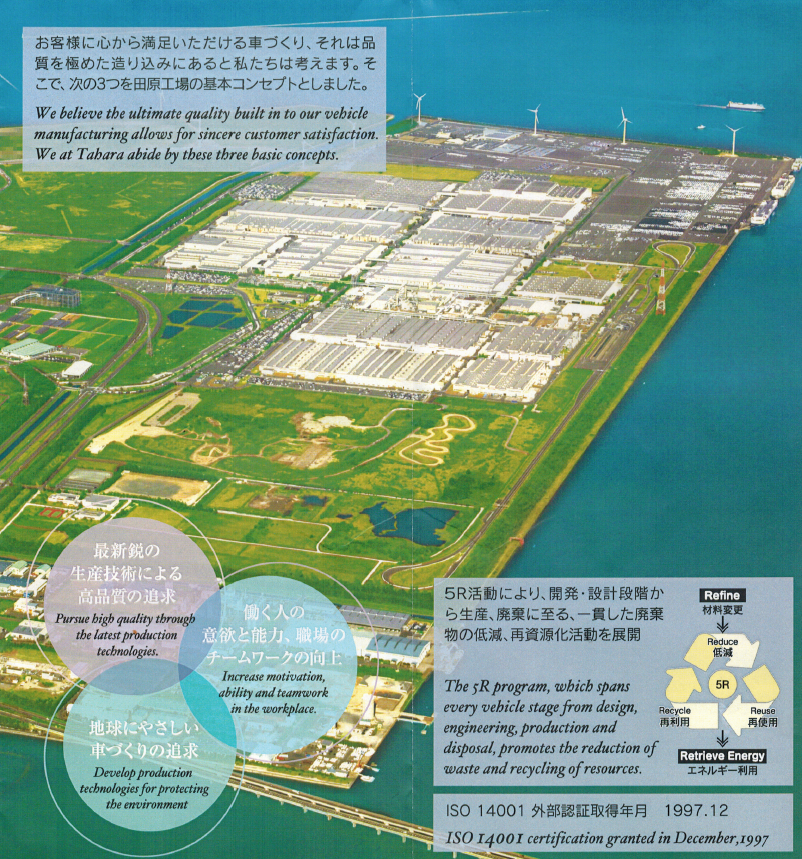YotaTech Tours Toyota’s Tahara Plant, Home of 4Runner & Land Cruiser

We get a rare inside look at Toyota’s most advanced assembly plant to see the high standards that go into creating our favorite trucks and SUVS.
Located on a long peninsula in Japan, Toyota’s Tahara assembly plant cuts a perfect shape out of the deep blue seas of the Pacific Ocean as it should. The plant and the land were literally built this way and this isn’t the only interesting thing about one of Toyota’s most advanced assembly plants.
Prior to opening in 1979, Tahara began life as a jagged coastline with volcanic rock. Despite the terrain, this didn’t stop Toyota from building a factory alongside the sea. They decided that its location, along the south of Japan, made it so ideal to their needs. So they automaker simply built the foundation, literally, that they needed to make it a success. Bringing in loads of dirt, Toyota “reclaimed” the land, as my tour guide told me, which meant they took the land back the ocean. Looking at the sprawling plant complex, it is easy to see the clearly-man made finished result: A straight shoreline with a sharp 90 degree turn.

With the dirt laid, the massive 43 million square-foot site area started to take shape with the addition of concrete and buildings. Today, the Tahara assembly plant consists of 15 different buildings, a heliport, a dock, four test tracks, and an on-site rest and recreation area (complete with a heated pool) for its approximate 8,000 emloyees.
The assembly plant builds cars and trucks including Lexus LS, GS, IS, IS F, GX as well as the Toyota Land Cruiser, Land Cruiser Prado, Vanguard, RAV4, WISH,and 4Runner. They also build engines like the 1GR V6, 3UZ V8, and 1UR. Total production of vehicles exceeds 300k units, while total engine production is around 300k units.

In order to get to Tahara, it is about a 90 minute ride from Toyota’s global headquarters in Aichi Prefecture, Japan. Interestingly, the two Toyota PR professionals I visit the plant with with with had never been to the facility. It was simply too far and nobody had ever asked to go to the plant before. The distance is an interesting thing about Japan since many people don’t drive that far. Instead, they use the trains or simply don’t go unless necessary.
Upon our arrival, we make our way to Number One assembly plant, home to the 4Runner, Land Cruiser, Lexus GX, and Land Cruiser Prado production. This plant produces around one thousand vehicles a day and runs two shifts.

The production process for the SUVs actually begins in the stamping plant where the body panels are built, then sent to a welding plant to put the panel together. Then, the body is sent off to get painted. From there, bumpers are added at the molding plant, before the cabin is sent to the assembly plant.

Inside the assembly plant, the frame and body are mated using robots, and the workers attach all the interior pieces like the dash and seats. This process, like the frame and body mating, is done with robots assisting workers to reduce the strain of installing the heavy pieces. It also helps protect the vehicle from dings and dents, which is also why the blue protective mats are used.

After all the interior pieces are attached, the doors are added, again with the aid of robots. This is done before the engine is filled with fluids and it is sent to the final inspection area. This is a fast process with a vehicle being built every 60 seconds.

This final inspection area is where much of the debate between Japanese production quality versus American production quality occurs. The inspectors are certified by the Japanese government. A final, rigorous, and possibly tedious inspection of the vehicles is mandated by law and overseen by the Japanese Ministry of Land, Infrastructure and Transport (MLIT). These inspectors have the power to pull vehicles off the line and send them back without discussion.
The certified inspectors are such a big deal that both Nissan and Subaru have recently had major recalls due to having uncertified inspectors checking their products.
These inspectors look at common things like lights, braking, speedometer accuracy, but they also go beyond this. They are concerned with fit and finish, paint, and performance. Every vehicle is driven off the assembly line, and then each Lexus vehicle and one out of five Toyota vehicles is driven around the outdoor test track to make sure it meets inspection.

Once the vehicles are inspected and ready to ship, they are sent to a massive parking lot for loading on a 55,000 ton ship. This ship can hold 5,000 vehicles at a time and it take two days to load. The loading process is simply the cars being driven into the holds and a bus coming around to pick up the drivers to repeat the process.
After filling up the ship, it makes its way around the world to deliver the vehicles. I was told takes about a week to get to California from the shipyard and four weeks to get to Florida.
All told, it is a very efficient process of having the docks right next to the factory and building vehicles basically from scratch in one location. While goods like raw materials are sent in, building and then shipping from one location without an extra transportation costs is a well-conceived idea.
The Tahara plant that has employed a fascinating process that puts a strong emphasis on quality. Check out more in the video below.
Photos for YotaTech by Tim Esterdahl
